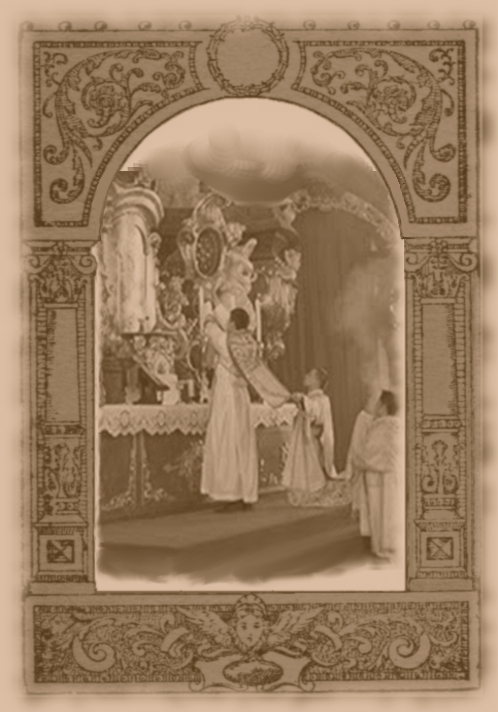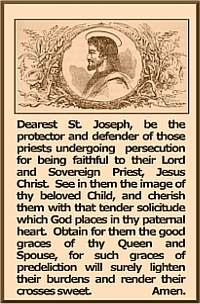Rorate Caeli continues with that excellent work of Don Pietro Leone which compares the TLM with the Missal of Paul VI. Please check their site for the full article:
 “Respect for the Real Presence is expressed by the many genuflections, the purification of the celebrant’s fingers in the chalice, the avoidance of contact with any profane object before they are purified, the purification of the sacred vessels on the corporal immediately after their use, the use of a pall to protect the chalice, the internal gilding of the vessels, the consecration of the immobile altar, the use of the pietra sacra and relics in the mobile altar and on the mensa when the Mass is said in a sacred place, of three altar-cloths, the reception of Holy Communion and the thanksgiving while kneeling (as opposed to the former standing and the latter sitting), the reception of Holy Communion on the tongue, the prescriptions in the case of a consecrated host falling to the ground, the prohibition that faithful and mass-servers touch the sacred vessels (see Critical Study IV 2).
“Respect for the Real Presence is expressed by the many genuflections, the purification of the celebrant’s fingers in the chalice, the avoidance of contact with any profane object before they are purified, the purification of the sacred vessels on the corporal immediately after their use, the use of a pall to protect the chalice, the internal gilding of the vessels, the consecration of the immobile altar, the use of the pietra sacra and relics in the mobile altar and on the mensa when the Mass is said in a sacred place, of three altar-cloths, the reception of Holy Communion and the thanksgiving while kneeling (as opposed to the former standing and the latter sitting), the reception of Holy Communion on the tongue, the prescriptions in the case of a consecrated host falling to the ground, the prohibition that faithful and mass-servers touch the sacred vessels (see Critical Study IV 2).
“The Reformer Martin Bucer, mentor of Thomas Cranmer, expressed the Protestant consensus as to the Real Presence (to which only Luther did not subscribe in virtue of his doctrine of consubstantiation) in his Censura when he said: “It becomes our duty to abolish from the churches… with all purity of doctrine whatever forms of bread-worship they wish to have employed by the anti-Christs and preserved in the hearts of the simpler kind of people” (MD p. 463).
“In the New Rite the Real Presence is no longer clearly expressed. The words denoting the oblata, in contradistinction to those quoted above (“a pure Victim…” etc. – words accompanied by 5 signs of the Cross) become panem vitae et calicem salutis: the bread of life and the cup of salvation (with no signs of the Cross), or, at another point, panis vitae…potus spiritualis: the bread of life and spiritual drink, which, as the Critical Study states, “could mean anything” (III 3), and suggest a merely spiritual, rather than a substantial presence.
“Moreover, all the signs of respect towards the Real Presence listed above have been abolished. We note particularly the abolition of the genuflections immediately following the consecration of the bread and wine.
In the years subsequent to the promulgation of the New Rite, further signs of respect were no longer enforced or obligatory[3], such as Communion on the tongue distributed by the priest or deacon, kneeling for the consecration, and genuflecting and keeping silent in the church. Instead, Holy Communion is usually received in the hands (a practice which Bucer prescribed explicitly in order to deny belief in the Real Presence (see above), and which became one of the hall-marks of the denial of Catholic eucharistic teaching[4]) and is often distributed moreover not only to standing communicants but also by lay ministers – where the New Rite has “out-Cranmered Cranmer” (MD p. 518)……
The post continues:
“In the Old Rite the sacramental priesthood is clearly distinguished from the laity.
“In the Offertory the priest speaks in the first person singular in the Suscipe Sancte Pater (the offering of the host) and in the other prayers.[8]
“In the Canon, the sacramental priesthood is distinguished from the laity by the words minister or servus in the first case and familia or plebs sancta in the second, and singled out by the phrases qui tibi offerunt hoc sacrificium… and nobis quoque peccatoribus (MD p. 345).
“The same distinction is made by the double Confiteor at the beginning of Mass (repeated at the end, depending on circumstances), the first Confiteor of which is said by the priest, the second by the faithful. Here the priest also exercises his priestly ministry in acting as judge, witness, and intercessor, and by imparting the absolution. The priest is differentiated from the people also in the double Holy Communion, in the first of which “the High and Eternal priest and he who acted in His person were fused into the most intimate union” (Critical Study V 2). “
 “Respect for the Real Presence is expressed by the many genuflections, the purification of the celebrant’s fingers in the chalice, the avoidance of contact with any profane object before they are purified, the purification of the sacred vessels on the corporal immediately after their use, the use of a pall to protect the chalice, the internal gilding of the vessels, the consecration of the immobile altar, the use of the pietra sacra and relics in the mobile altar and on the mensa when the Mass is said in a sacred place, of three altar-cloths, the reception of Holy Communion and the thanksgiving while kneeling (as opposed to the former standing and the latter sitting), the reception of Holy Communion on the tongue, the prescriptions in the case of a consecrated host falling to the ground, the prohibition that faithful and mass-servers touch the sacred vessels (see Critical Study IV 2).
“Respect for the Real Presence is expressed by the many genuflections, the purification of the celebrant’s fingers in the chalice, the avoidance of contact with any profane object before they are purified, the purification of the sacred vessels on the corporal immediately after their use, the use of a pall to protect the chalice, the internal gilding of the vessels, the consecration of the immobile altar, the use of the pietra sacra and relics in the mobile altar and on the mensa when the Mass is said in a sacred place, of three altar-cloths, the reception of Holy Communion and the thanksgiving while kneeling (as opposed to the former standing and the latter sitting), the reception of Holy Communion on the tongue, the prescriptions in the case of a consecrated host falling to the ground, the prohibition that faithful and mass-servers touch the sacred vessels (see Critical Study IV 2).


